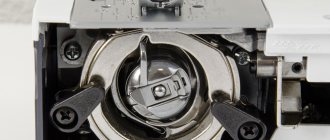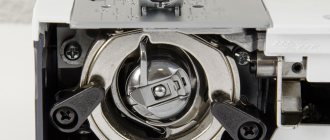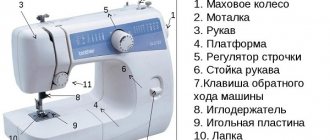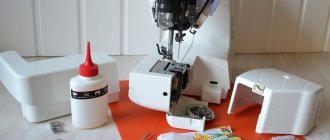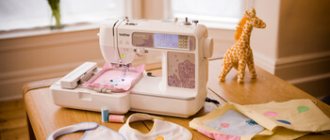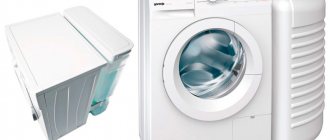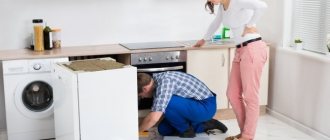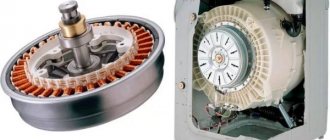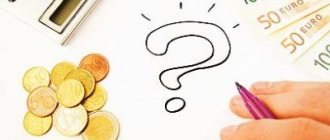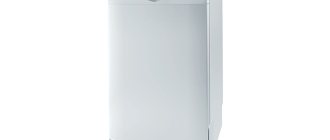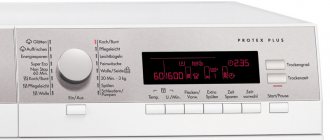How to choose a sewing needle? This question is asked by everyone who starts sewing. A needle is one of the most important components of the sewing process and a lot depends on its correct choice! Once you start working with the wrong needle, problems will not keep you waiting: from torn threads to a broken sewing machine. We'll tell you how to choose a sewing needle depending on the project you're doing and the fabric you've chosen for it. In order to navigate the assortment of needles offered by stores, you do not need to have knowledge of the technical intricacies of production. It is enough to understand the marking methods and know what the parts of the needle are called. After a short theoretical part, we will help you choose a needle for any occasion!
Main parts of machine needle
- The bulb is the thick upper part of the needle that is fixed in the sewing machine. The flask of industrial needles is completely round, while the flask of household needles is flat on one side.
- The blade (shaft) of the needle is the main narrow part; it is its diameter that becomes the size of the needle.
- Eyelet is the hole into which the thread is threaded.
- Groove (groove) is a notch along the front of the needle, from the bulb to the eye.
- The point is the tapering part from the eye to the tip of the needle
- The tip is the end of the needle and comes in different shapes depending on the type of needle.
Hand Needles Hand needles are simpler and consist of an eye, a shaft, a point and a tip.
Overlock needles Overlock needles have the same parts as regular machine needles, but are made slightly differently and cannot replace each other.
How are needles different from each other?
Initially, sewing needles are divided into two large categories - overlock needles and for household sewing machines. They are not interchangeable. The main visible difference between them is the size of the eye - overlock needles have a larger one.
Sewing machine needles have a number of differences, namely:
- sharpening;
- flask;
- ear shape;
- groove dimensions;
- needle diameter;
- intended for a specific type of fabric.
These are only some of the differences visible to the eye that directly affect the quality of the stitching.
To ensure that sewing products from various materials does not become a problem for you, it is not enough just to read the instructions for the sewing machine. You need to have an idea about the marking of needles and their systematization.
When purchasing, you need to know the type of sewing machine, and it is also advisable to have a needle bottle with you.
The bulb is a part of the needle that is inserted into a special hole when installed on the machine. Manufacturers put markings on it.
If there is no flask left, you can find the required markings in the instructions or on the device itself.
When choosing, the main guideline will be the numbers and letters on the flask or needle packaging.
Household sewing machines use needles with a flat bulb. Round needles are designed for industrial sewing machines.
The meaning of the numbers in the markings
The marking on the flask usually looks like this: “130/705H” or “HAx1”. The numbers indicate the needle size and shaft diameter. The unit of measurement is inches or mm multiplied by 100.
Needles with numbers from 60/8 to 120/19 are suitable for household sewing machines.
Two standards are used for designation - European (mm) and American (inches).
The thickest needle is marked 200/25, and the thinnest is 50/5, where the first number indicates fractions of a millimeter and the second indicates fractions of an inch.
Letter meaning
Now let’s figure out what the letters indicated in the marking next to the number mean. Here are the main types of sewing machine needles:
- N - universal (for simple fabrics like cotton, linen, etc.);
- HJ - for thick fabrics (jeans, tarpaulin, etc.);
- N-M - microtex (silk, taffeta, raincoat fabric);
- HS - for elastic (stretch) materials (knitwear, synthetics);
- N-E - embroidery;
- N-EM - metallized threads. There are only two numbers - 80 (for thin fabrics) and 90 (for dense ones);
- HQ - quilting (for decorative stitches in the same type of needlework);
- H-SUK - round point (jersey, thick knits, knits);
- H-LR and H-LL - for skin;
- N-O - for decorative finishing;
- H-ZWI - double (decorative trim, tucks, etc.);
- H-DRI - triple needle;
- Topstitch – needles for decorative stitches.
Depending on your intentions, you need to choose a needle with the desired marking.
Needle marking
Hand needles are produced without special markings. Their name reflects their functions: universal sewing, embroidery, darning, for leather, for beads, etc. Also on the packaging is the needle size: from 1 to 15 or 13-26 (different systems). The sewing machine needle is marked with a special code that will help you find the right needle even without packaging. This code consists of numbers and letters and is located on the flask. The numbers are the diameter (thickness) of the needle, measured in hundredths of a millimeter or fractions of an inch. For example, the number 60 corresponds to a thickness of 0.6 mm. Sometimes the manufacturer indicates both sizes, then the values are written as 80/12. The letters will tell you which machines and materials this needle should work with. The letter H stands for a universal needle; its tip is slightly rounded. Clarifications regarding the type of fabric are added with a hyphen.
Marking options
Recently, color designations for needles have been used: blue bulbs for denim needles, crimson bulbs for microtex needles, yellow bulbs for knitwear needles.
Types of needles for sewing machines
Residents of Moscow and St. Petersburg can easily choose the right tool - variety allows. If you live in a small town, online shopping will be your salvation. They can order parts of all sizes and shapes for any sewing machine. There is no need to worry about delivery by mail, because this is a group of goods that is difficult to damage. The cost of quality products is affordable, and if you are serious about sewing, you should not skimp on tools - a bad needle can seriously damage the fabric. Which manufacturers have become the favorites of professionals?
For knitwear
The tool should not cut the fabric, so it is advisable to choose samples with a round tip. The part does not pierce the threads, but passes between them. The best options for knitwear: HS, H-SUK, H-SES. Popular model:
- Name: SCHMETZ Stretch 130/705 HS.
- Price: 125 rubles.
- Characteristics: set of 5 copies – 2×65, 2×75, 1×90. Material of manufacture: nickel. The flask is cut, diameter 2.04 mm.
- Pros: excellent product quality, suitable for highly elastic knitted materials, standard bulb size for household sewing machines.
- Cons: none found.
The German company Schmetz is a leader in the production of goods in this category. Sewing needles for machines from this manufacturer break extremely rarely. Product ideal for knitwear:
- Name: SCHMETZ Jersey 130/705 H-SUK Combi.
- Price: 89 rub.
- Characteristics: set contains 5 needles – 1×70, 2×80, 1×90, 1×100. Made of nickel, steel color. The flask is cut, diameter 2.04 mm.
- Pros: Best choice for knitwear.
- Cons: none found.
For skin
Another titan in the production of needles for various purposes is the Japanese company ORGAN NEEDLE co. Ltd. Experienced seamstresses know that the Lady and the Organ emblem is a symbol of reliability. For dense materials, craftswomen use the following model:
- Name: Machine leather needle Organ Needles Leder Leather Cuir130/705 H-LL.
- Price: 270 rub.
- Characteristics: set contains 5 samples – 3x90, 2x100. Suitable for working with suede, pigskin, calfskin, goatskin.
- Pros: long service life, excellent stitch quality.
- Cons: there are factory defects with defective ears, there are many fakes on sale.
Another German company produces quality products. The Groz-Beckert brand (the name Grotz-Beckert is often found on the Internet) specializes in the creation of industrial needles. For leather the company has the following set:
- Name: Groz-Beckert DBx1 LR.
- Price: 190 rub.
- Characteristics: set includes 10 copies No. 90/14. The length from the beginning of the needle eye to the base is 33.8 mm. The thickness of the flask is 1.62 mm. The product is intended for upright machines, creates a diagonal seam with a slope to the right.
- Pros: low rate of breakage, thread breakage, stitch skipping, high cut quality, long service life.
- Cons: not suitable for home sewing machines.
For denim
The very sharp end of the HJ type piece fits neatly into thick fabric without damaging the threads. The needlewomen liked this set of tools:
- Name: Prym Nadeln Jeans 130/705.
- Price: 271 rub.
- Characteristics: set includes 5 samples No. 90/14. Material of manufacture – steel, color – silver. The smoothing size corresponds to the needle size.
- Pros: the eyelet is well polished, which prevents damage to the thread, the parameters of the part ensure ideal loop formation and error-free threading.
- Cons: expensive.
There are needles on sale from domestic manufacturers. They are cheap, so needlewomen for whom sewing is a rare hobby buy them. Budget proposal:
- Name: Needle for Artie jeans.
- Price: 42 rub.
- Characteristics: set includes 5 samples No. 100. Manufacturing material – tool steel.
- Pros: inexpensive, works well.
- Cons: often break and bend.
For finishing stitch
Using a double or triple needle you can make beautiful finishing seams. The H-ZWI, H-DRI tool is not suitable for all machines, but only for those with a zigzag stitch (Singer, Brother, Janome, Juki and others), and it works exclusively in straight stitch mode. The following model is popular:
- Name: Double needles for Hemline knitwear.
- Price: 189 rub.
- Characteristics: the set contains one copy No. 80, the distance between the rods is 4 mm. Manufacturing material – steel. Suitable for creating decorative stitching on knitted, elastic fabric with thick pile. The tip is rounded.
- Pros: durable, does not damage fibers, suitable for all modern machines.
- Disadvantages: does not always make the perfect line, is whimsical in work.
Particularly beautiful stitches are obtained when using a triple needle. To make a decorative seam perfect, you need to choose a high-quality tool, for example:
- Name: SCHMETZ Universal Triple Needle H-DRI.
- Price: 169 rub.
- Characteristics: the set contains one universal specimen No. 80 with a distance between the rods of 2.5 mm. Material of manufacture: nickel.
- Pros: convenient plastic case for storage and carrying, high durability of the product.
- Cons: none found.
Double needle
A tool with two rods is designed for making decorative seams that do not experience heavy loads. If you need to embroider parallel elements of a design at the same time, a double needle is indispensable. Popular Tool:
- Name: Hemline Klasse double embroidery.
- Price: 151 rub.
- Characteristics: one copy No. 75 with a distance between the rods of 3 mm. Product length – 3.8 cm. Color: steel, red. Purpose: finishing with stitching after embroidering with polyester or rayon threads on thin fabrics.
- Pros: a large hole into which the thread can be easily threaded; it is convenient to store the product in a plastic case.
- Cons: requires reduced speed in operation.
- Permanent eyebrow makeup hair technique
- Anaerobic load - what is it. Anaerobic workouts for weight loss and fat burning with video
- Causes of diabetes mellitus
Sales on this part are rare because the price is affordable. The price category of the following manufacturer is higher than that of other well-known brands, but the quality is consistent:
- Name: Prym Double Needle 130/705.
- Price: 271 rub.
- Characteristics: one copy No. 100, width between rods 6 mm. The point is rounded, intended for knitwear.
- Pros: durable, long lasting.
- Cons: none found.
With wings
Using a sword-shaped needle, you can create beautiful openwork stitches and hemstitching. Top seller in category:
- Name: SCHMETZ Hemstitch Needle 130/705 H WING.
- Price: 180 rub.
- Characteristics: the set contains one copy No. 100/16 with two longitudinal projections (wings) on the rod. Used on loosely woven materials.
- Pros: The sewing machine needle is of impeccable quality.
- Cons: none found.
A tool with wings creates an openwork pattern that looks especially impressive on fabrics with a loose weave structure: cambric, linen, cotton. Popular Product:
- Name: Hemline Klasse for hemstitching.
- Price: 215 rub.
- Characteristics: the set contains one copy No. 100/16. Product length – 3.9 cm.
- Pros: lasts a long time, durable, does not bend.
- Cons: expensive.
Self-threading needle
The tool is convenient for those who find it difficult to thread a needle. At the same level as the eyelet there is a slot through which the thread is passed, after which it enters the eyelet itself. The model is optimal for working with medium-weight fabrics. Self-threading needles for sewing machines are extremely rare on sale; there are no such sets in the lines of well-known manufacturers. If a person has difficulty threading, you can use the following tool:
- Name: Threader for Hemline 136 sewing machine.
- Price: 218 rub.
- Characteristics: the set includes two threaders - a needle threader (extra-long for overlockers and sewing machines), a loop threader (thin threader for overlockers).
- Pros: makes it easier to insert the thread into the eye.
- Cons: It is not clear from the manufacturer’s description how to use the device.
Manufacturing companies
In sewing supply stores you will find a large selection of needles from different companies. What sewing needles are best to buy? We advise you to choose needles from trusted manufacturers: the German companies Schmetz and Grotz-Beckert, as well as the Japanese company Organ Needles. The products of these companies justify their price with a wide range and excellent quality, especially for special needles (knitwear, stretch, etc.). Universal economy class needles are produced by the Russian group and the Australian company Hemline.
The curator of the supply of Schmetz needles in the Russian Federation, Elmar Brandt, explained that all Schmetz needles are made from the same wire. Then, depending on the type, the needles are plated with nickel or chromium.
The best needle manufacturers
The modern market offers a huge selection of machine needles. Today, some of the best products are considered to be from companies such as:
Schmetz (Germany)
Grotz-Beckert (Germany)
Hemline (Australia)
Needles Arti (Russia)
Organ Needles (Japan)
These manufacturers, including a domestic company, offer sewing needles for various applications, which are distinguished by their reliability and excellent quality.
Sewing needles
Now let's find out how to choose a sewing needle. We will focus on the type of material you will use in your work.
Universal needle
Denim needle
Needle for tightly woven materials (microtex)
Knitting needle
Needle for stretch materials
For hand embroidery
For hand cross stitch, use short needles, up to 3 cm long. They have a rounded point that gently pushes the fabric weave apart, and an elongated oval-shaped eye into which it is convenient to insert floss threads in several layers. These needles are also called tapestry needles and have sizes from 13 to 28. For embroidery with satin or artistic satin stitch, you should take longer and sharper needles. For embroidery, you can also use a special double-sided needle.
It is longer than regular needles and has a hole in the middle for thread. A double-ended needle is designed to allow you to embroider with both hands without turning the needle, which significantly saves time. When working with beads, take the thinnest needles with the same thin eye. This needle will easily fit into the thin hole of the bead.
For machine embroidery, use special needles!
For machine embroidery
They are made more durable to cope with increased impact loads.
And, although the price of such needles is significantly higher, the service life of an embroidery needle is much longer. Most often, 75/11 needles are used for embroidery; 90/14 needles are suitable for working on thick fabrics. Embroidery needles are distinguished by red bulbs and the following letter codes
For industrial sewing machines
The main difference from household models is the rounded shape of the instruments. The length and purpose are also not the same as those of the analogues presented above. The most famous companies producing needles with the appropriate characteristics:
- "Organ";
- "Grotz-Beckert";
- "Schmetz."
These companies offer needles for different purposes, including for Singer machines:
- Blind seam.
- Devices for simulating hand stitching.
- Coverstitching machines.
- Riveting machines for which your own option will be suitable.
- Button.
- Furriers.
- Erect.
- Embroidery The product will definitely be of high quality if you choose it correctly.
- Overlockers, and so on.
Each device has its own marking, this factor is also paid attention to. Only in this case will the needle last a long time.
Features of work
Additional selection tips
In the case of a point, there are two main groups of devices:
- For textile group, with rounded end.
- For leather, with blade shape. Mass is not that important.
Only with the right choice of needle can you get a beautiful stitch look. In this case, it is easier to avoid various damage to the material. The thinnest type of foundation will hold up.
Pay attention. The streamlining of the eye of the needle, together with the external shape, leads to the unhindered passage of the point through the eye. The inner side of the latter remains smooth, which facilitates the movement of any materials. Interweaving or breaking of the thread does not occur under such circumstances.
A good loop depends on the shape of the gutter. Previously, the main one was the so-called “round groove”. But now it is a thing of the past, it is being replaced with a device called Pontoon. This is the groove that prevents the appearance of defects both in the threads and in the needles themselves. The French manufacturer adheres to the same rules.
You might be interested in this: Patterns and sewing of a fluffy dress for a girl
The force with which the needle pierces the fabric depends on the design of the needle pin. The service life is also largely determined by this parameter.
Interesting. The needle holder inside the sewing machine is usually made with a certain diameter. If the size of the flask and the holder do not correspond to each other, the machine simply cannot be used for its intended purpose.
Working with leather and fur
Skin needles are produced with an unusual tip shape. It looks like a spatula, has a beveled edge and a triangular sharpening. Hand needle leather needle size from 1 to 8. Machine leather needles are marked
They pierce the material at an angle of 45 or 135 degrees to the seam line itself, thus creating a beautiful inclination of the stitches (to the right or to the left). Sizes from 90/14 to 110/18. To hand stitch fur, use the same needles as for leather. A machine for stitching natural fur is called a furrier machine. Choose needles for such a machine following the instructions; unlike ordinary needles, they are not universal. For thinner fur, such as mink, needles of size 40-60 are suitable, for thick sheepskin - size 80.
Drawing conclusions
Useful materials
Needles for straight stitch sewing machines
134 (DPx5) - needle for machines with a thick bulb. Needle sizes: from No. 65 to No. 150
134R (DPx5) 134LR (DPx5)
1738 (DBx1) - needle for machines with a thin bulb.
Needle sizes: from No. 55 to No. 130 1738R (DBx1) 1738SES (DBx1) Types of sharpening:
R - standard, for sewing products from textile fabrics of various densities
SERV - with recessed flat and reinforced base to avoid skipped stitches
SES - rounded point, for sewing knitwear from thin to medium
LR - cutting edge with a right slant, for sewing leather goods ( LL - with a left slant)
SPI - pointed, for sewing products from tightly woven fabrics (microfiber, silk)
TITANIUM - titanium coated, for sewing materials with a low fiber melting threshold
135×17 (DPx17) - needle for machines on heavy fabrics. Needle sizes: from No. 80 to No. 180
135x17R (DPx17) 135x17S (DPx17)
Types of sharpening:
R - standard sharpening
S - blade-shaped, used for making decorative seams in the production of shoes, bags, belts
LR - cutting point, for sewing leather goods
TITANIUM - titanium coated, for sewing materials with a low fiber melting threshold
Overlock needles
B27 (DCx27) - overlock needle. Needle sizes: from No. 60 to No. 120
B27R (DCx27) B27SES (DSx27)
Types of sharpening:
R - standard, for sewing products from textile fabrics of various densities.
SES - rounded point, for sewing knitwear.
Needles for cover stitch machine
UY 128 GAS - needle for a flat-stitch (cover-stitch) machine. Needle sizes: from No. 65 to No. 120
UY128GASR UY128GASSES
Types of sharpening:
R - standard sharpening
SES - rounded point, for knitwear
Needles for special sewing machines
134-35— a needle for special sewing machines. Needle sizes: from No. 70 to No. 140
134-35R 134-35SES
Types of sharpening:
R - standard sharpening
SES - rounded point, for sewing knitwear
SPI - pointed, for sewing products from tightly woven fabrics (microfiber, silk)
Needles for buttonhole machines
558 (DOx558) - needle for chain stitch machines
558 (DOx558) 558SUK (DOx558)
Types of sharpening:
R - standard sharpening
SUK - rounded point, does not damage artificially aged denim
Needles for button machines
TQx1 - needle for button machines, for flat buttons. Needle sizes: from No. 80 to No. 90
TQx1 TQx1SES
TQx7 - needle for button machines, for buttons with stems. Needle sizes from No. 80 to No. 90
TQx7 TQx7SES
Types of sharpening:
R - standard sharpening
SES - rounded point
- Forward
